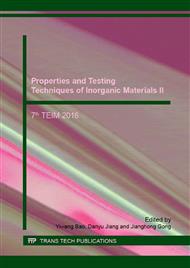p.271
p.276
p.282
p.287
p.292
p.297
p.303
p.308
p.316
Effect of the Ratio of Co to Ni+Co on the Microstructures and Mechanical Properties of Ti(C, N)-Based Cermets
Abstract:
The microstructures of the prepared Ti(C, N)-based cermets with various ratios of Co to Ni+Co were studied using X-ray diffractometry (XRD) and scanning electron microscopy (SEM). Mechanical properties such as transverse rupture strength (TRS), fracture toughness (K1C) and hardness (HRA) were also measured. The results showed that when Ni was partly replaced by Co, the core size of hard particle and the thickness of rim phase changed. With the increasing of the ratio of Co to Ni+Co, the porosity of the cermets increased gradually, the fracture toughness of the cermets decreased gradually, the transverse rupture strength increased firstly and then decreased, the hardness changed slightly。When the ratio of Co to Ni+Co was 0.2, the cermets had better transverse rupture strength (TRS), which was characterized by fine grains and the moderate thickness of rim phase in the binder.
Info:
Periodical:
Pages:
292-296
Citation:
Online since:
January 2017
Authors:
Keywords:
Price:
Сopyright:
© 2017 Trans Tech Publications Ltd. All Rights Reserved
Share:
Citation:


